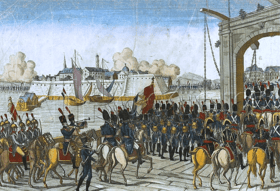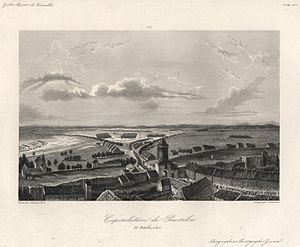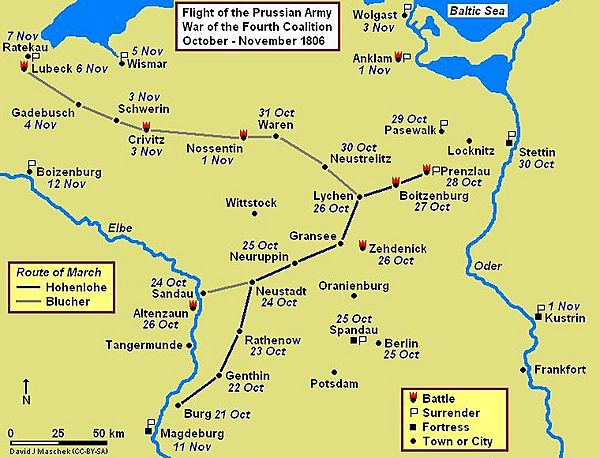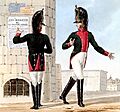Capitulation of Stettin facts for kids
Quick facts for kids Capitulation of Stettin |
|||||||
|---|---|---|---|---|---|---|---|
| Part of the War of the Fourth Coalition | |||||||
 Taking of Stettin by French troops in 1806 |
|||||||
|
|||||||
| Belligerents | |||||||
| Commanders and leaders | |||||||
| Strength | |||||||
| 500 men, 2 guns | 5,300 men, 281 guns | ||||||
| Casualties and losses | |||||||
| None | 5,300 captured, 281 guns captured |
||||||
The Capitulation of Stettin was a surprising event during the War of the Fourth Coalition. On October 29–30, 1806, a small French cavalry force tricked a much larger Prussian army into surrendering. This happened in Stettin, a port city in Prussia, which is now called Szczecin in Poland. It's located on the Oder River near the Baltic Sea.
This surrender was one of many times Prussian soldiers gave up to French forces. This happened after their huge defeat at the Battle of Jena-Auerstedt on October 14. The Prussian army was very discouraged and disorganized.
After the big battle, the defeated Prussian armies tried to escape. They crossed the Elbe River and headed northeast. They hoped to reach the other side of the Oder River. However, a French commander named Joachim Murat chased them for two weeks. He caught over 10,000 Prussians at the Battle of Prenzlau. Murat cleverly made them believe they were surrounded by a huge army. This bluff led them to surrender on October 28.
The very next day, another 4,200 Prussians surrendered at Capitulation of Pasewalk. This happened when two French cavalry brigades, one led by Antoine Lasalle, cornered them. Later that afternoon, Lasalle arrived at the fortress of Stettin. He demanded that the Prussian commander, Friedrich Gisbert Wilhelm von Romberg, surrender the city.
General Romberg was very nervous. He believed that 30,000 French soldiers were outside the city. In reality, Lasalle only had about 500 cavalrymen and two cannons. Romberg began talks with Lasalle and agreed to surrender Stettin that very night. About 5,300 Prussian soldiers and 281 cannons were captured without a fight.
Contents
Why the Prussians Surrendered
The Big Defeat at Jena-Auerstedt
The main reason for the Prussian army's low spirits was a massive defeat. On October 14, 1806, Napoleon I of France's army, called the Grande Armée, completely crushed the Prussian and Saxon armies. This battle was called the Battle of Jena-Auerstedt.
After this disaster, the Prussian forces had to retreat. Many of their top commanders were badly hurt or killed. The main Prussian commander, Charles William Ferdinand, Duke of Brunswick, was fatally wounded. Another important general, Ernst von Rüchel, was also seriously injured.
The French Chase
The French army, especially the cavalry led by Joachim Murat, quickly pursued the retreating Prussians. They wanted to capture as many Prussian soldiers as possible. The Prussians tried to escape across the Elbe River and then the Oder River.
French forces marched towards Berlin, which they captured on October 27. Napoleon then sent Murat and other generals north from Berlin. Their goal was to cut off the main Prussian army, led by Frederick Louis, Prince of Hohenlohe-Ingelfingen.
The Bluff at Prenzlau
On October 28, Murat finally caught up with Hohenlohe's army at Prenzlau. French cavalry attacked the Prussian column. Murat then used a clever trick. He made Hohenlohe believe that a huge French army, much larger than it actually was, had surrounded them.
Hohenlohe, with his tired and demoralized troops, fell for the bluff. He surrendered his remaining 10,000 soldiers. This was a huge blow to the Prussian army.
The Surrender of Stettin
Lasalle's Demand
After the surrender at Prenzlau, General Lasalle rode towards Stettin. He arrived in the early afternoon of October 29. Lasalle immediately demanded that the city surrender. At first, the Prussian commander, General Romberg, refused.
However, Lasalle sent another message at 4:00 p.m. This time, he threatened to treat the city harshly if it didn't surrender. He also repeated the false claim that a massive French army of 30,000 men was ready to attack. In reality, the closest large French force was still far away.
Romberg's Decision
General Romberg was an old man, nearly 80 years old. He was completely unnerved by Lasalle's threats and the false information. He believed the French general and decided to negotiate. During the night of October 29-30, Romberg agreed to surrender Stettin.
He handed over the fortress, 5,300 Prussian troops, and 281 cannons. The French force that achieved this victory was incredibly small. Lasalle had only about 800 cavalrymen from the 5th and 7th Hussar Regiments, plus two cannons.
Neither of Romberg's top officers protested the surrender. They both agreed to it. Later, in 1809, Romberg was found guilty of giving up Stettin without a fight. He was sentenced to life in prison, but he died before his punishment began.
Historians have called the surrender of Stettin "shameful." The city had enough soldiers and supplies to withstand a siege. Even if the fortress wasn't perfect, the troops could have crossed the Oder River. They could have joined their Russian allies and continued fighting.
Napoleon was very pleased with this easy victory. He congratulated Murat, saying, "My compliments on the capture of Stettin; if your light cavalry thus takes fortified towns, I must disband the engineers and melt down my heavy artillery." This shows how surprised and impressed he was by the French cavalry's success.
Aftermath of the Surrender
More Fortresses Fall
After Stettin, other Prussian fortresses also fell quickly. The fortress of Küstrin surrendered on November 1. This was another easy victory for the French.
Prussian Columns Captured
Several isolated groups of Prussian soldiers were also hunted down and captured. These included groups at Boldekow, Anklam, and Wolgast.
By November 3, only one main Prussian army remained in the area between the Elbe and Oder rivers. This force was led by Gebhard von Blücher. There were also Prussian garrisons (groups of soldiers defending a place) in cities like Magdeburg and Hameln.
Blücher wanted to march his 21,000 men to the port of Rostock and escape by sea. However, his plan was overruled. Instead, he tried to march east to join other Prussian forces. But the French, led by Soult, Bernadotte, and Murat, finally caught up to Blücher at the Battle of Lübeck on November 6.
Images for kids







